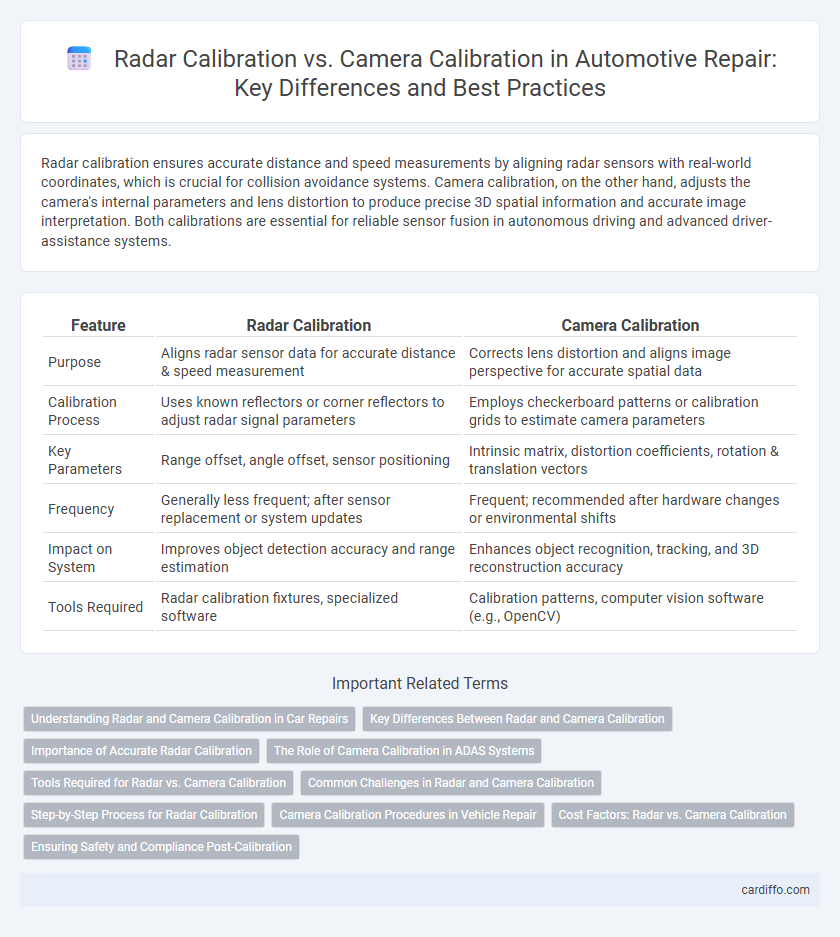Radar calibration ensures accurate distance and speed measurements by aligning radar sensors with real-world coordinates, which is crucial for collision avoidance systems. Camera calibration, on the other hand, adjusts the camera's internal parameters and lens distortion to produce precise 3D spatial information and accurate image interpretation. Both calibrations are essential for reliable sensor fusion in autonomous driving and advanced driver-assistance systems.
Table of Comparison
| Feature | Radar Calibration | Camera Calibration |
|---|---|---|
| Purpose | Aligns radar sensor data for accurate distance & speed measurement | Corrects lens distortion and aligns image perspective for accurate spatial data |
| Calibration Process | Uses known reflectors or corner reflectors to adjust radar signal parameters | Employs checkerboard patterns or calibration grids to estimate camera parameters |
| Key Parameters | Range offset, angle offset, sensor positioning | Intrinsic matrix, distortion coefficients, rotation & translation vectors |
| Frequency | Generally less frequent; after sensor replacement or system updates | Frequent; recommended after hardware changes or environmental shifts |
| Impact on System | Improves object detection accuracy and range estimation | Enhances object recognition, tracking, and 3D reconstruction accuracy |
| Tools Required | Radar calibration fixtures, specialized software | Calibration patterns, computer vision software (e.g., OpenCV) |
Understanding Radar and Camera Calibration in Car Repairs
Radar calibration in car repairs ensures accurate sensor alignment for advanced driver-assistance systems by adjusting the radar sensor to correctly interpret distances and speeds, while camera calibration focuses on aligning the camera's field of view to detect lane markings, signs, and obstacles precisely. Both calibrations require specialized diagnostic tools and software to restore sensor accuracy after windshield replacements or collision repairs. Proper calibration of radar and camera systems is critical to maintaining vehicle safety features like adaptive cruise control and lane-keeping assist.
Key Differences Between Radar and Camera Calibration
Radar calibration involves aligning sensor measurements with real-world distances and velocities using known reference points, emphasizing accuracy in range and speed detection. Camera calibration focuses on correcting lens distortion, determining intrinsic parameters, and estimating the camera's position relative to the environment for precise image mapping. Key differences include radar's reliance on electromagnetic wave reflection properties versus camera's dependence on visual feature extraction and pixel coordinate transformations.
Importance of Accurate Radar Calibration
Accurate radar calibration is crucial for ensuring precise object detection and distance measurement in advanced driver-assistance systems (ADAS), directly impacting vehicle safety and performance. Unlike camera calibration, which optimizes image recognition and lane detection, radar calibration fine-tunes the sensor's ability to detect objects in various weather and lighting conditions. Proper radar calibration minimizes false positives and negatives, enhancing collision avoidance and adaptive cruise control functionalities.
The Role of Camera Calibration in ADAS Systems
Camera calibration in ADAS systems is crucial for accurate perception and object detection, enabling features such as lane departure warnings and pedestrian recognition. Unlike radar calibration, which focuses on distance and velocity measurement through radio waves, camera calibration adjusts intrinsic parameters like focal length and lens distortion to ensure precise image interpretation. Proper calibration enhances the reliability of sensor fusion, improving overall vehicle safety and automated driving performance.
Tools Required for Radar vs. Camera Calibration
Radar calibration requires specialized signal generators and radar reflectors to ensure accurate distance and velocity measurements, relying on tools that simulate specific radar signatures and environmental conditions. Camera calibration demands high-precision calibration targets such as checkerboard patterns or AprilTags, coupled with software capable of rectifying lens distortion and aligning multiple camera feeds. Both processes depend heavily on diagnostic devices and software suites tailored to their respective sensor technologies for precise alignment and functionality verification.
Common Challenges in Radar and Camera Calibration
Radar calibration faces challenges such as signal reflection, environmental noise, and precise distance measurement errors, while camera calibration struggles with lens distortion, varying lighting conditions, and accurate feature detection. Both sensors require high-precision alignment with the vehicle's coordinate system to ensure reliable sensor fusion, complicating the calibration process. Inaccurate calibration can lead to erroneous perception data, impacting advanced driver assistance systems (ADAS) and autonomous driving performance.
Step-by-Step Process for Radar Calibration
Radar calibration involves precise alignment of the radar sensor using a step-by-step process that includes initializing the sensor, collecting raw radar data, and applying correction algorithms to adjust for environmental factors and hardware variances. Unlike camera calibration, which focuses on lens distortion correction and perspective transformation, radar calibration emphasizes timing synchronization and Doppler frequency adjustments to ensure accurate distance and velocity measurements. The process requires specialized calibration targets and software tools to iteratively refine sensor parameters for optimal performance in advanced driver-assistance systems (ADAS) and autonomous vehicles.
Camera Calibration Procedures in Vehicle Repair
Camera calibration in vehicle repair involves adjusting the camera system to ensure accurate image capture and processing, essential for advanced driver-assistance systems (ADAS) functionality. Procedures include positioning the vehicle on a flat surface, using specialized calibration targets, and running diagnostic software to fine-tune camera alignment and lens parameters. Proper camera calibration improves object detection accuracy and system reliability, directly impacting vehicle safety and performance.
Cost Factors: Radar vs. Camera Calibration
Radar calibration typically incurs higher costs due to the need for specialized equipment, complex signal processing, and precise environmental conditions. Camera calibration costs are generally lower, leveraging standard calibration patterns and widely available software tools. Budget considerations should factor in maintenance frequency, calibration complexity, and the technology's operational environment.
Ensuring Safety and Compliance Post-Calibration
Radar calibration and camera calibration are critical processes for maintaining vehicle safety and regulatory compliance after repair. Accurate radar calibration ensures precise distance measurement and object detection, preventing collision risks, while proper camera calibration guarantees correct image interpretation for lane-keeping and pedestrian recognition systems. Both calibrations must meet manufacturer specifications and industry standards to secure optimal performance of advanced driver-assistance systems (ADAS) and pass mandatory safety inspections.
Radar calibration vs Camera calibration Infographic

 cardiffo.com
cardiffo.com